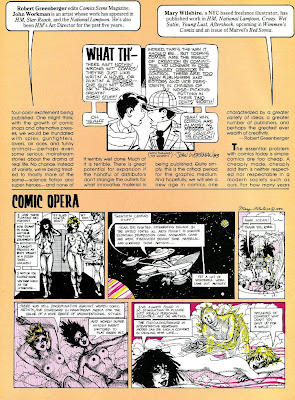'Heavy Metal' magazine, March 1983
March, 1983...... the single 'The Safety Dance', by Canadian group Men Without Hats, is released in the US, after having some degree of chart success in Canada at the end of 1982. The accompanying video , shot in the English village of West Kington, soon is in heavy rotation on MTV.
The latest issue of Heavy Metal magazine is on the stands, with a wraparound cover by Carol Donner. The advertising gets a bit quirky, with a full-page ad from Gold Eagle Books, the publisher of 'mack Bolan' and other adventure novels. Undoubtedly, Gold Eagle was hoping to tap into the young white male market served by Heavy Metal.
The Dossier section leads off with Rok Critic Lou Stathis turning his attention to...comic books !? Fear not, Stathis's commentary is as pretentious and self-serving as for his Rock reviews. Indeed, the entire Dossier section for this issue is devoted to comics.
Also chipping in their two cents' worth are comics creators and luminaries Walt Simonson, Byron Preiss, Will Eisner, Art Spiegelman, and Harvey Kurtzman.
One of the best features of this month's issue is a lengthy interview with underground comix legend S. Clay Wilson, responsible for such beloved characters as the Checkered Demon, Ruby the Dyke, and Star-Eyed Stella. Sadly, Wilson remains disabled and in poor health from a brain injury suffered in November, 2008.
From the interview: "The Angels were fighting in one room, while (Janis) Joplin was singing to the hippies in the other. It was like one of my drawings come to life."
Brilliant !
Among the better comic strips appearing in the March issue is the violent, satirical 'Lamar: Killer of Fools' by P. Setbon and P. Poirier.















































































